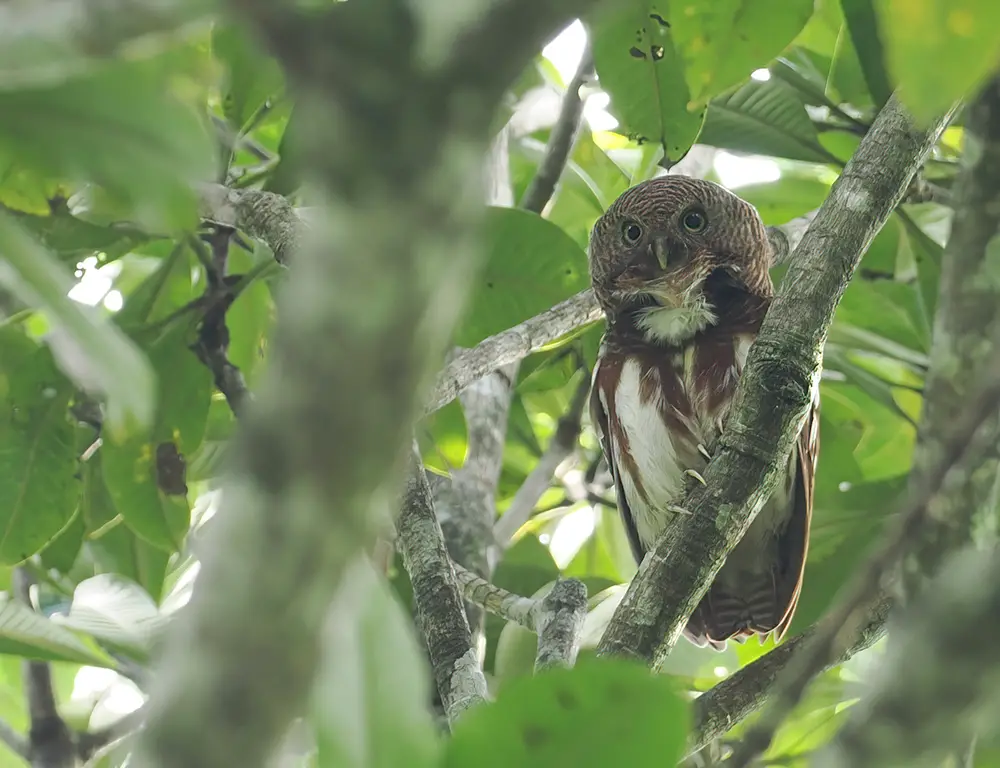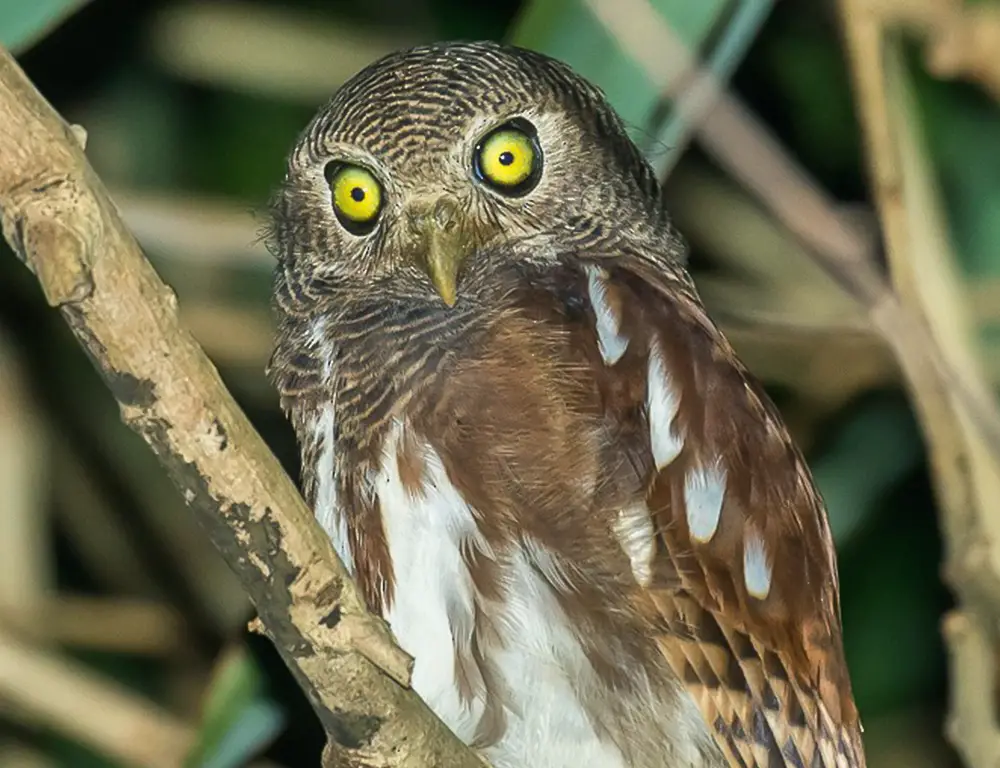In the realm of nocturnal avian species, the Javan Owlet emerges as a captivating yet often overlooked creature inhabiting the lush landscapes of Indonesia.
This diminutive bird, belonging to the Strigidae family, possesses a charm woven from its unique traits, captivating bird enthusiasts with its petite stature and distinctive calls.
What distinguishes the Javan Owlet is its size and affinity for dense rainforest habitats, thriving amidst the humid and tropical environments many owls avoid.
A fascinating narrative unfolds through countless hours of research and observation, revealing the adaptations that enable these shy creatures to flourish in their chosen ecosystem.
Join me as we delve deeper into the intriguing world of the Javan Owlet, unraveling its mysteries and uncovering the secrets of its survival.

Physical Characteristics of the Javan Owlet
The Javan Owlet (Glaucidium castanopterum) possesses several distinctive physical characteristics that contribute to its unique appearance and adaptations for survival. Here’s an overview:
Size
Javan Owlets are relatively small birds, measuring approximately 20-21 centimeters (7.9-8.3 inches) in length. They are compact and agile, well-suited for navigating through dense forest environments.
Weight
On average, Javan Owlets weigh around 98 grams (3.5 ounces). Their lightweight build enables them to fly swiftly and quietly, essential for their nocturnal hunting habits.
Plumage
Their plumage is predominantly greyish-brown, which provides excellent camouflage against the bark of trees in their forest habitat. They have white spotting on the chest and belly areas, adding to their cryptic appearance.
Eyes
One of the most striking features of the Javan Owlet is its large, piercing yellow eyes. These eyes are well-adapted to low-light conditions, enhancing their nocturnal hunting capabilities.
Beak and Talons
Javan Owlets have sharp, curved beaks and powerful talons that capture and subdue their prey. Their hunting strategy often involves swooping silently from perches to surprise their prey.
Wings and Flight
They have rounded wings designed for agile flight in dense forest environments. Their flight is characterized by silent wingbeats, facilitated by the softness of their feathers, allowing them to approach prey stealthily.
Habitat and Distribution of the Javan Owlet
The habitat and distribution of the Javan Owlet (Glaucidium castanopterum) are closely tied to the diverse landscapes of the Indonesian islands, particularly Java, where it is most commonly found.
Here’s an overview of its habitat preferences and distribution:
Habitat
- Lowland Rainforests: Javan Owlets prefer dense lowland rainforests with diverse flora and fauna. These forests provide ample cover for hunting, nesting, roosting, and protection from predators.
- Semi-Evergreen Forests: They also inhabit semi-evergreen forests, characterized by a mix of deciduous and evergreen tree species. These habitats offer resources and shelter similar to lowland rainforests, supporting Javan Owlet populations.
- Plantations and Suburban Gardens: Despite their preference for natural forest habitats, Javan Owlets demonstrate adaptability and can also be found in human-modified landscapes such as plantations and suburban gardens.
However, the availability of suitable habitat elements like trees with dense foliage is essential for their survival in such environments.
Distribution
- Java Island: As the name suggests, Java Island is the primary stronghold of the Javan Owlet population. They are distributed across various island parts, including natural and human-dominated landscapes.
- Bali, Borneo, and Sumatra: While Java Island serves as the core of their range, Javan Owlets can also be found on neighboring Indonesian islands such as Bali, Borneo, and parts of Sumatra. However, their presence in these areas may be less common compared to Java.
- Specific Locations: Within their range, Javan Owlets tend to inhabit areas with suitable forest cover, nesting sites, and prey availability. They may be more abundant in specific regions or protected areas where their habitat remains relatively intact.
Behavior and Diet of the Javan Owlet
The behavior and diet of the Javan Owlet (Glaucidium castanopterum) are intricately linked to its status as a nocturnal predator.
Here’s an overview of its behavior and dietary preferences:
Behavior
- Nocturnal Activity: Like most owls, Javan Owlets are primarily active at night. They have adapted to low-light conditions, utilizing their keen senses to hunt for prey under darkness.
- Silent Movement: Javan Owlets possess specialized feathers that allow them to fly silently. This silent flight enables them to approach prey without alerting them, enhancing their hunting success.
- Camouflage: During the day, Javan Owlets roost in dense foliage or tree holes, utilizing their cryptic plumage to blend seamlessly with their surroundings. This camouflage helps them avoid predator detection and allows them to rest undisturbed.
- Territoriality: Javan Owlets may exhibit territorial behavior, defending their nesting sites and hunting grounds from intruders, including other owls.
- Vocalizations: While generally silent during the day, Javan Owlets may vocalize with distinct hoots and calls at night. These vocalizations serve various purposes, including communication with mates and territory defense.
Diet
- Small Mammals: Javan Owlets primarily prey on small mammals such as rodents (rats and mice). They use their sharp talons and beaks to capture and consume these prey.
- Insects: Besides mammals, Javan Owlets feed on various insects, including beetles and spiders. These tiny arthropods provide a supplementary food source, particularly during periods when mammalian prey may be scarce.
- Reptiles: Occasionally, Javan Owlets may target small reptiles like lizards as part of their diet. While not as common as mammalian prey, reptiles offer another source of protein and nutrients.
- Other Birds: Although less frequent, Javan Owlets may opportunistically prey on other birds, particularly those nesting nearby. This behavior is more likely when alternative prey options are limited.
Conservation Status of the Javan Owlet

The conservation status of the Javan Owlet (Glaucidium castanopterum) is a cause for concern due to various threats to its habitat and population.
Here’s an overview of its conservation status:
IUCN Red List Status
The Javan Owlet is listed as “Vulnerable” on the International Union for Conservation of Nature (IUCN) Red List of Threatened Species. This designation indicates that the species faces a high risk of extinction in the wild if conservation measures are not implemented.
Threats
- Habitat Loss and Degradation: Deforestation, primarily for agricultural purposes such as palm oil and timber plantations, poses the most significant threat to the Javan Owlet’s habitat. The conversion of forests into agricultural land results in the loss of critical nesting sites, foraging areas, and habitat connectivity.
- Urbanization: Rapid urbanization and infrastructure development further encroach upon the Javan Owlet’s habitat, fragmenting forested areas and increasing human-wildlife conflicts.
- Illegal Logging: Illegal logging activities contribute to habitat destruction and degradation, exacerbating the loss of suitable habitat for the Javan Owlet and other wildlife species.
- Hunting and Capture: Despite legal protections, Javan Owlets are sometimes targeted by hunters and captured for the illegal pet trade. This exploitation further reduces their populations and disrupts their natural behaviors.
Conservation Efforts
- Protected Areas: Establishing and effectively managing protected areas and nature reserves can help safeguard critical habitats for the Javan Owlet and other threatened species.
- Habitat Restoration: Efforts to restore degraded habitats, including reforestation and habitat rehabilitation projects, are essential for increasing the availability of suitable habitat for the Javan Owlet.
- Community Engagement: Engaging local communities in conservation initiatives, promoting sustainable land use practices, and raising awareness about the importance of conserving the Javan Owlet can foster support for conservation efforts.
- Legislative Measures: Strengthening and enforcing laws and regulations to combat illegal logging, hunting, and wildlife trade are crucial for protecting the Javan Owlet and addressing key threats to its survival.
- Research and Monitoring: Continued research on the ecology, population dynamics, and distribution of the Javan Owlet is essential for guiding conservation strategies and monitoring population trends over time.
FAQs
What are the reproductive habits of the Javan Owlet?
Breeding typically occurs during specific seasons, with pairs forming monogamous bonds. They nest in tree hollows or cavities, where females lay eggs, and both parents share incubation and chick-rearing duties.
What are the natural predators of the Javan Owlet?
While adult Javan Owlets have few natural predators due to their nocturnal habits and cryptic plumage, their nests and young may be vulnerable to predation by larger birds of prey, snakes, and mammals.
How do Javan Owlets contribute to ecosystem health?
As apex predators, Javan Owlets help regulate prey populations, preventing the overpopulation of smaller mammals and insects. This, in turn, maintains the balance within their ecosystem, promoting biodiversity and ecological stability.
What is the lifespan of a Javan Owlet in the wild?
The lifespan of a Javan Owlet in the wild can vary, but they are known to live for several years, with some individuals reaching up to a decade or more in favorable conditions.
Do Javan Owlets migrate?
Javan Owlets are generally sedentary birds, meaning they do not undertake long-distance migrations. However, local movements within their range may occur searching for food or suitable nesting sites.
Conclusion
The Javan Owlet is a testament to nature’s resilience and adaptability, thriving amidst habitat loss and urbanization challenges. Its remarkable ability to inhabit forest and urban environments highlights its noteworthy adaptability.
Belonging to the Strigidae family and primarily found on Java Island, Indonesia, this bird exhibits a striking mix of brownish-grey and white plumage and sustains itself mainly on insects and small vertebrates.
Its survival challenges underscore broader environmental issues, emphasizing the importance of habitat conservation.
Understanding and protecting creatures like the Javan Owlet equips us to live more harmoniously with nature, ensuring the continued existence of diverse ecosystems for generations to come.
